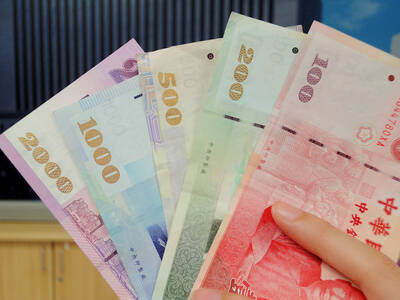Rescuers braved aftershocks yesterday to pull bodies from the rubble and search for survivors after Peru's most devastating earthquake in nearly four decades left at least 500 dead.
Wednesday's mammoth earthquake wrought untold destruction -- especially along Peru's southern coast, which accounted for the greatest number of casualties.
One official estimate put the number of dead at around 500, although that figure was likely to climb sharply as rescuers continued to retrieve corpses from collapsed buildings.
"The toll has jumped to between 500 and 510 dead and 1,600 injured," said Roberto Ocno, the head of the country's firefighter service.
"There are dead trapped under houses," he said. "There are several bodies in the streets, people who may have died from heart attacks."
Civil defense authorities offered a somewhat lower toll, saying some 437 people had died and 829 had been injured.
The US Geological Survey upgraded the quake to a rare 8.0 on the Moment Magnitude scale, as the Peruvian government said helicopters and planes were airlifting emergency aid to the hard-hit coastal towns.
Peruvian President Alan Garcia, while visiting the stricken area on Thursday, declared three days of national mourning for the earthquake victims, closing all public buildings including schools, military bases and museums.
The powerful quake cut a path of devastation throughout southern Peru.
Buildings collapsed, major highways to the coast were ripped apart and power lines knocked out by the quake, leaving overwhelmed local officials issuing urgent appeals for help.
"We have hundreds of dead lying in the streets, and injured people in the hospital. It is totally indescribable," Pisco Mayor Juan Mendoza said.
"Seventy percent of the town is devastated," Mendoza said.
"We don't have water, no communications, the houses are collapsed, the churches are destroyed," he said.
Rescuers on Thursday pulled six survivors from the church of San Clemente that collapsed during a funeral mass packed with mourners. Many dead were still believed to be lying under the rubble.
Some 50 corpses lay on a Pisco sidewalk covered with blankets as shocked survivors numbly surveyed the scene.
Elsewhere in Peru, the quake claimed two lives in Lima from heart attacks as tens of thousands spent the night on the streets fearing more tremors.
Tsunamis flooded fishing villages on the Paracas bay, causing some damage, locals said.
And in Chincha, some 600 inmates fled the local penitentiary after the quake struck, authorities said.
Embassies in Lima were concerned about the death of foreign nationals in Paracas, a popular tourist spot near Pisco that has been cut off since the earthquake struck.
Already shredded nerves were kept in a state of constant anxiety as more than 300 aftershocks, some as powerful as 6.3 on the Moment Magnitude scale, shook Peru after the main earthquake.
Aftershocks "can last up to three weeks" after a quake of Wednesday's magnitude, said Hernan Talavera of the Geophysical Institute of Peru.
The Peruvian Red Cross sent an team overland from Lima that took seven hours to reach Pisco instead of the usual two.
The UN said it was ready to help and the Geneva-based International Federation of the Red Cross said it sent two planes loaded with relief supplies for the earthquake victims.
Foreign governments and aid groups launched relief efforts, including the US, Canada, Spain, Italy and France. Peru's neighbors have also mobilized including Ecuador, Bolivia, Brazil, Mexico, Venezuela, Colombia and Chile.

People can preregister to receive their NT$10,000 (US$325) cash distributed from the central government on Nov. 5 after President William Lai (賴清德) yesterday signed the Special Budget for Strengthening Economic, Social and National Security Resilience, the Executive Yuan told a news conference last night. The special budget, passed by the Legislative Yuan on Friday last week with a cash handout budget of NT$236 billion, was officially submitted to the Executive Yuan and the Presidential Office yesterday afternoon. People can register through the official Web site at https://10000.gov.tw to have the funds deposited into their bank accounts, withdraw the funds at automated teller

PEACE AND STABILITY: Maintaining the cross-strait ‘status quo’ has long been the government’s position, the Ministry of Foreign Affairs said Taiwan is committed to maintaining the cross-strait “status quo” and seeks no escalation of tensions, the Ministry of Foreign Affairs (MOFA) said yesterday, rebutting a Time magazine opinion piece that described President William Lai (賴清德) as a “reckless leader.” The article, titled “The US Must Beware of Taiwan’s Reckless Leader,” was written by Lyle Goldstein, director of the Asia Program at the Washington-based Defense Priorities think tank. Goldstein wrote that Taiwan is “the world’s most dangerous flashpoint” amid ongoing conflicts in the Middle East and Russia’s invasion of Ukraine. He said that the situation in the Taiwan Strait has become less stable

CONCESSION: A Shin Kong official said that the firm was ‘willing to contribute’ to the nation, as the move would enable Nvidia Crop to build its headquarters in Taiwan Shin Kong Life Insurance Co (新光人壽) yesterday said it would relinquish land-use rights, or known as surface rights, for two plots in Taipei’s Beitou District (北投), paving the way for Nvidia Corp to expand its office footprint in Taiwan. The insurer said it made the decision “in the interest of the nation’s greater good” and would not seek compensation from taxpayers for potential future losses, calling the move a gesture to resolve a months-long impasse among the insurer, the Taipei City Government and the US chip giant. “The decision was made on the condition that the Taipei City Government reimburses the related

FRESH LOOK: A committee would gather expert and public input on the themes and visual motifs that would appear on the notes, the central bank governor said The central bank has launched a comprehensive redesign of New Taiwan dollar banknotes to enhance anti-counterfeiting measures, improve accessibility and align the bills with global sustainability standards, Governor Yang Chin-long (楊金龍) told a meeting of the legislature’s Finance Committee yesterday. The overhaul would affect all five denominations — NT$100, NT$200, NT$500, NT$1,000 and NT$2,000 notes — but not coins, Yang said. It would be the first major update to the banknotes in 24 years, as the current series, introduced in 2001, has remained in circulation amid rapid advances in printing technology and security standards. “Updating the notes is essential to safeguard the integrity